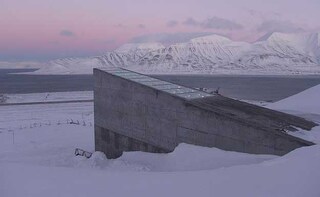Way up on a remote island, closest to the North Pole, lies the world’s largest seed storage. From different countries, crates of seeds of the most prized crops in the world are shipped here for safe and secure storage in a cold vault. Set in permafrost deep inside a mountain, the Svalbard Seed Vault was launched in 2008 by the Norwegian government.
Frozen surroundings reduce the reliance on mechanical refrigeration. The vault was built to be disaster proof and earthquake resistant, secured against external damage (even an asteroid strike!) and climate change to last for an infinite lifetime. Situated well above the sea-level, the frozen depository is surrounded by snowcapped slopes overlooking the stillness of beautiful blue waters and narrow valleys.The roof of the building is adorned with artwork created by Dyveke Sanne. The artist used highly reflective stainless steel triangles of various sizes along with mirror and prisms that catch and reflect light. It has a stunning view that makes the building glow under the sun and even on a dark gloomy day.
(Luxury Food Shortage Scares - Should we Believe the Warnings?)The vault holds more than 860,000 samples of varieties of food crops like beans, wheat, rice and about 4000 plant species. With a capacity to store about 2.5 billion seeds, it is home to the world’s largest collection of crop diversity. It preserves all important crop varieties that are available in the world today. These are duplicates of the seed samples originating from almost every country across the globe. Ranging from maize, rice, jowar and wheat from Africa and Asia to European and South American staples like eggplant, lettuce and potato.The seeds are sealed in custom made three-ply foil packages that are stored inside boxes and placed on various shelves inside the vault. The vault needs to maintain a temperature of -18 degree Celsius at all times to limit oxygen access and slow metabolic activity. These samples remain the property of the gene banks and countries that deposit them.
The vault is maintained by Cary Fowler of the Global Crop Diversity Trust in partnership with the Norwegian government and the Nordic Genetic Resources Center. The guardians of the vault focus on safeguarding as many unique crops as they can in order to offer future generations a steady food supply while the world struggles with the challenges of climate change and rapid population growth. Governments from Washington to India, store back-up copies of their most precious plant resources here. In an event of crop failure or destruction, the world could bank on the Svalbard Seed Vault to breed new varieties.Less than eight years of inception, the vault plans to stage the first ‘return-to-sender’ project in the war-torn country of Syria in the Middle East where the international center is under great threat due to the ongoing crisis.The Svalbard Seed Vault presents an undeniably fascinating story celebrating years of conserving our inheritance and what's left of it. The technology is state of art but the bigger question that it faces is if it can really feed the future or it is merely a media sensation? Time will tell.All images have been sourced from Flickr/ Landbruks- og matdepartementet
Frozen surroundings reduce the reliance on mechanical refrigeration. The vault was built to be disaster proof and earthquake resistant, secured against external damage (even an asteroid strike!) and climate change to last for an infinite lifetime. Situated well above the sea-level, the frozen depository is surrounded by snowcapped slopes overlooking the stillness of beautiful blue waters and narrow valleys.The roof of the building is adorned with artwork created by Dyveke Sanne. The artist used highly reflective stainless steel triangles of various sizes along with mirror and prisms that catch and reflect light. It has a stunning view that makes the building glow under the sun and even on a dark gloomy day.
(Luxury Food Shortage Scares - Should we Believe the Warnings?)The vault holds more than 860,000 samples of varieties of food crops like beans, wheat, rice and about 4000 plant species. With a capacity to store about 2.5 billion seeds, it is home to the world’s largest collection of crop diversity. It preserves all important crop varieties that are available in the world today. These are duplicates of the seed samples originating from almost every country across the globe. Ranging from maize, rice, jowar and wheat from Africa and Asia to European and South American staples like eggplant, lettuce and potato.The seeds are sealed in custom made three-ply foil packages that are stored inside boxes and placed on various shelves inside the vault. The vault needs to maintain a temperature of -18 degree Celsius at all times to limit oxygen access and slow metabolic activity. These samples remain the property of the gene banks and countries that deposit them.
The vault is maintained by Cary Fowler of the Global Crop Diversity Trust in partnership with the Norwegian government and the Nordic Genetic Resources Center. The guardians of the vault focus on safeguarding as many unique crops as they can in order to offer future generations a steady food supply while the world struggles with the challenges of climate change and rapid population growth. Governments from Washington to India, store back-up copies of their most precious plant resources here. In an event of crop failure or destruction, the world could bank on the Svalbard Seed Vault to breed new varieties.
Advertisement
For the latest food news, health tips and recipes, like us on Facebook or follow us on Twitter and YouTube.
Advertisement
